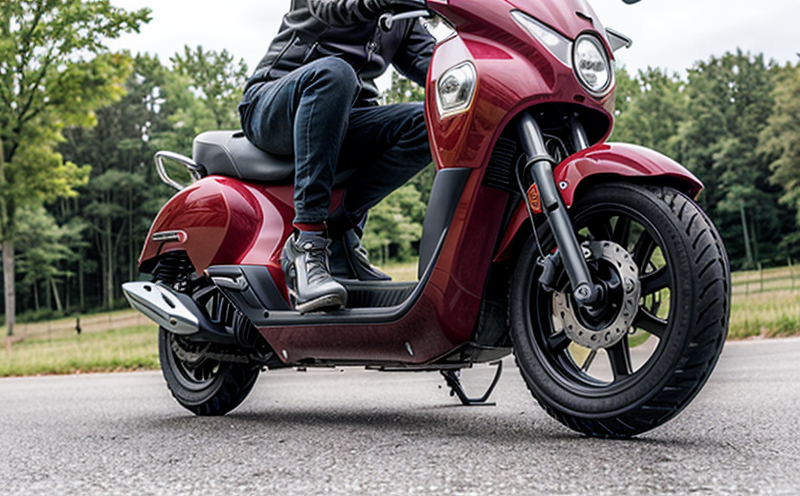Vibration Resistance Testing for E-Scooter Handlebars and Steering Systems
Vibration Resistance Testing for E-Scooter Handlebars and Steering Systems Ensuring the Safety and Reliability of Your Products
In recent years, the e-scooter market has experienced explosive growth, with millions of units sold worldwide. As a result, manufacturers are under increasing pressure to produce high-quality products that meet the demands of consumers while also ensuring compliance with regulatory requirements. One critical aspect of e-scooter design is the handlebar and steering system, which requires rigorous testing to ensure its safety and reliability.
Vibration Resistance Testing for E-Scooter Handlebars and Steering Systems is a laboratory service provided by Eurolab that simulates real-world vibrations to assess the performance of these components. This article will delve into the importance of vibration resistance testing for e-scooter handlebars and steering systems, highlighting its benefits and advantages.
What is Vibration Resistance Testing?
Vibration Resistance Testing involves subjecting e-scooter handlebars and steering systems to controlled vibrations that mimic real-world conditions, such as road irregularities, potholes, or other external factors. The test is designed to assess the durability, reliability, and performance of these components under various vibration frequencies and amplitudes.
Why is Vibration Resistance Testing Essential for E-Scooter Manufacturers?
The benefits of vibration resistance testing for e-scooter handlebars and steering systems are multifaceted
Improved Safety By assessing the performance of these critical components, manufacturers can identify potential safety risks associated with their products. This enables them to make necessary design changes or modifications to prevent accidents and injuries.
Enhanced Reliability Vibration resistance testing ensures that e-scooter handlebars and steering systems can withstand various environmental conditions, reducing the likelihood of mechanical failures or breakdowns.
Compliance with Regulatory Requirements Many countries have established strict guidelines for e-scooter safety, including regulations related to vibration performance. By conducting vibration resistance testing, manufacturers can ensure compliance with these standards, avoiding costly recalls, fines, and reputational damage.
Reduced Warranty Claims Products that pass vibration resistance testing are less likely to experience mechanical failures, resulting in lower warranty claims and reduced customer dissatisfaction.
Key Benefits of Vibration Resistance Testing
Here are the key benefits of using vibration resistance testing for e-scooter handlebars and steering systems
Assesses Performance under Real-World Conditions Eurolabs vibration resistance testing simulates real-world vibrations, providing manufacturers with a comprehensive understanding of their products performance.
Identifies Potential Safety Risks By subjecting e-scooter handlebars and steering systems to controlled vibrations, manufacturers can identify potential safety risks and make necessary design changes or modifications.
Ensures Compliance with Regulatory Requirements Vibration resistance testing ensures compliance with regulatory requirements, avoiding costly recalls, fines, and reputational damage.
Reduces Warranty Claims Products that pass vibration resistance testing are less likely to experience mechanical failures, resulting in lower warranty claims and reduced customer dissatisfaction.
QA Frequently Asked Questions about Vibration Resistance Testing for E-Scooter Handlebars and Steering Systems
What types of e-scooters can benefit from vibration resistance testing?
All types of e-scooters, including folding, electric, and scooter motorcycles, can benefit from vibration resistance testing.
How do I prepare my e-scooter handlebars or steering system for vibration resistance testing?
Provide Eurolab with your product specifications, design documentation, and any relevant test data to ensure a smooth testing process.
What are the typical test conditions used in vibration resistance testing?
Vibration resistance testing typically involves subjecting e-scooter handlebars and steering systems to controlled vibrations at various frequencies (e.g., 5-20 Hz) and amplitudes (e.g., 1 mm).
How long does a typical vibration resistance test take?
The duration of a vibration resistance test varies depending on the specific testing requirements, but it can typically range from several hours to several days.
What is the typical turnaround time for receiving test results?
Eurolab provides rapid turnaround times for vibration resistance testing, ensuring that you receive your test results promptly.
Conclusion
Vibration Resistance Testing for E-Scooter Handlebars and Steering Systems is a critical laboratory service provided by Eurolab that ensures the safety and reliability of these components. By simulating real-world vibrations, manufacturers can identify potential safety risks, ensure compliance with regulatory requirements, reduce warranty claims, and enhance the overall performance of their products.
At Eurolab, we understand the importance of vibration resistance testing for e-scooter manufacturers. Our state-of-the-art laboratory facilities, expert technicians, and rigorous testing protocols guarantee accurate and reliable results. Contact us today to learn more about our vibration resistance testing services and how they can benefit your business.
About Eurolab
Eurolab is a leading provider of laboratory services specializing in e-scooter and mobility product testing. With years of experience and expertise in vibration resistance testing, we offer a comprehensive range of services designed to meet the evolving needs of manufacturers in the e-scooter industry.




